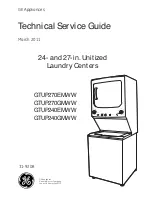
PELLERIN MILNOR CORPORATION
BIWUUI02 (Published) Book specs- Dates: 20001108 / 20001108 / 20100609 Lang: ENG01 Applic: WUU
About the Forces Transmitted by Milnor
®
Washer-extractors
During washing and extracting, all washer-extractors transmit both static and dynamic (cyclic)
forces to the floor, foundation, or any other supporting structure. During washing, the impact of
the goods as they drop imparts forces which are quite difficult to quantify. Size for size, both
rigid and flexibly-mounted machines transmit approximately the same forces during washing.
During extracting, rigid machines transmit forces up to 30 times greater than equivalent flexibly-
mounted models. The actual magnitude of these forces vary according to several factors:
• machine size,
• final extraction speed,
• amount, condition, and type of goods being processed,
• the liquor level and chemical conditions in the bath preceding extraction, and
• other miscellaneous factors.
Estimates of the maximum force normally encountered are available for each Milnor
®
model and
size upon request. Floor or foundation sizes shown on any Milnor
®
document are only for on-
grade situations based only on previous experience without implying any warranty, obligation, or
responsibility on our part.
1.
Rigid Machines
Size for size, rigid washer-extractors naturally require a stronger, more rigid floor, foundation, or
other supporting structure than flexibly-mounted models. If the supporting soil under the slab is
itself strong and rigid enough and has not subsided to leave the floor slab suspended without
support, on grade installations can often be made directly to an existing floor slab if it has enough
strength and rigidity to safely withstand our published forces without transmitting undue
vibration. If the subsoil has subsided, or if the floor slab itself has insufficient strength and
rigidity, a deeper foundation, poured as to become monolithic with the floor slab, may be
required. Support pilings may even be required if the subsoil itself is “springy” (i.e., if its
resonant frequency is near the operating speed of the machine). Above-grade installations of rigid
machines also require a sufficiently strong and rigid floor or other supporting structure as
described below.
2.
Flexibly-mounted Machines
Size for size, flexibly-mounted machines generally do not require as strong a floor, foundation, or
other supporting structure as do rigid machines. However, a floor or other supporting structure
having sufficient strength and rigidity, as described in
Section 3
, is nonetheless vitally important
for these models as well.
3.
How Strong and Rigid?
Many building codes in the U.S.A. specify that laundry floors must have a minimum live load
capacity of 150 pounds per square foot (732 kilograms per square meter). However, even
compliance with this or any other standard does not necessarily guarantee sufficient rigidity. In
any event, it is the sole responsibility of the owner/user to assure that the floor and/or any other
supporting structure exceeds not only all applicable building codes, but also that the floor and/or
any other supporting structure for each washer-extractor or group of washer-extractors actually
has sufficient strength and rigidity, plus a reasonable factor of safety for both, to support the
weight of all the fully loaded machine(s) including the weight of the water and goods, and
including the published 360º rotating sinusoidal RMS forces that are transmitted by the
machine(s). Moreover, the floor, foundation, or other supporting structure must have sufficient
9
Содержание 30015T6X
Страница 2: ......
Страница 31: ...Service and Maintenance 1 27 ...
Страница 40: ......
Страница 41: ...Drive Assemblies 2 37 ...
Страница 46: ......
Страница 47: ...Cylinder Shell and Bearing Assemblies 3 43 ...
Страница 62: ......
Страница 63: ...Door Assemblies 4 59 ...
Страница 73: ...Chemical Supply Devices 5 69 ...
Страница 79: ...Water and Steam Piping and Assemblies 6 75 ...
Страница 95: ...Control and Sensing Assemblies 7 91 ...














































